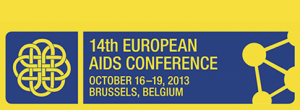Osteoporosis triples risk of later fracture in 1000-person US HIV group
1 December 2013. Related: Conference reports, Coinfections and complications, EACS 14 Brussels 2013.
 Mark Mascolini, for NATAP.org
Mark Mascolini, for NATAP.org
Only three factors independently predicted a new fracture in a combined analysis of the US HOPS and SUN Study HIV cohorts – older age, smoking, and osteoporosis. Osteopenia did not affect fracture risk in multivariate or univariate analyses.
Several studies confirm a higher fracture rate in people with than without HIV infection. For example, in a 5826-person HIV Outpatient Study (HOPS) analysis, HOPS members 25 to 54 years old had a higher fracture rate and a higher relative proportion of fragility fractures than did a general population comparison group [2]. Low bone mineral density (BMD) is frequent in HIV populations, but a link between low BMD and subsequent fracture had not been demonstrated in people with HIV.
To explore the possible association between low BMD and later fracture – which has been demonstrated in the general population – CDC researchers and collaborators analysed combined data from the SUN Study and HOPS, two prospective US cohorts. They focused on people who had at least one DEXA scan to determine BMD and follow-up to the last patient contact or to June 2012 (SUN) or September 2012 (HOPS). They defined osteopenia and osteoporosis by DEXA-measured T score in the standard way, and they defined incident fracture as all fractures.
Median age of the combined 1008-person groups was 42 (interquartile range [IQR] 35 to 48), 83% were men, 68.5% men who have sex with men (MSM), and 67% non-Hispanic white. Median CD4 count stood at 408 (IQR 254 to 598). More than half of cohort members (54%) were current or former smokers, and 12% had HCV infection.
DEXA scans determined that 366 people (36.3%) had osteopenia and 29 (2.9%) had osteoporosis. Sixty people (6%) had a fracture before follow-up began. People with osteopenia or osteoporosis were significantly older and included significantly higher proportions of men, MSM, and whites. People with osteoporosis had a significantly lower average nadir CD4 count than those without osteoporosis (92 versus 200, p = 0.008). HCV infection was more prevalent in people with osteoporosis (27.6%) or osteopenia (14.5%) than in those with neither condition (10.1%) (p = 0.003).
Significantly more people with osteoporosis than with osteopenia or neither condition already had a fracture when follow-up began (20.7% versus 6.6% versus 4.9%, p = 0.009), and significantly more people with osteoporosis had a new fracture during follow-up (31% versus 10.1% versus 8%, p = 0.003).
During a median follow-up of 5 years, 95 people (9.4%) fractured a bone. Fractures were most common in the rib/sternum (18), hand (17), foot (15), and wrist (11). Compared with people who did not break a bone during follow-up, those who did were significantly older (median 43 versus 41, p = 0.007) and more likely to be a current or former smoker (65.3% versus 53.1%, p = 0.031), to have HCV infection (20.0% versus 11.4%, p = 0.023), and to have a previous fracture (12.6% versus 5.3%, p = 0.008).
People with a new fracture were less likely to have normal bone density (T score > -1) and more likely to have a T score below -2.5, indicating osteoporosis (p = 0.002). Median BMD was -1.0 (IQR -2.1 to -0.4) in people who broke a bone during follow-up and -0.7 (IQR -1.4 to -0.1) in those who did not.
Multivariate analysis identified three factors associated with a higher risk of fracture during follow-up.
Osteoporosis tripled the risk (adjusted hazard ratio [aHR] 3.0, 95% confidence interval [CI] 1.5 to 6.3), every additional 10 years of age raised the risk 40% (aHR 1.4, 95% CI 1.1 to 1.7), and current or former smoking upped the risk 50% (aHR 1.5, 95% CI 1.0 to 2.3) (P < 0.05 for all associations). Factors not independently associated with incident fracture in this analysis were osteopenia, current or nadir CD4 count, gender, injection drug use versus MSM transmission risk, public versus private insurance, and HCV infection.
The HOPS/SUN team noted that this analysis is limited by their inability to distinguish fragility fractures from other fractures. They questioned whether fracture reporting and smoking data were complete in these patients and suspected underreporting of fractures. The investigators suggested that channeling bias my affect their results: people referred for DEXA scanning may be those with more fracture risk factors. They also cautioned that women made up only 17% of the study group. Because the analysis found a strong association between osteoporosis and subsequent fracture in this relatively young population, the researchers suggested that DEXA screening may be a valuable clinical tool in people with HIV.
References:
- Battalora L, Buchacz K, Armon C, et al. Low bone mineral density is associated with increased risk of incident fracture in HIV-infected adults. 14th European AIDS Conference. October 16-19, 2013. Brussels. Abstract PS1/4.
http://www.eacsmobile.org/libraryEntry/show/1123575513598368155 - Young B, Dao CN, Buchacz K, Baker R, Brooks JT; HIV Outpatient Study (HOPS) Investigators. Increased rates of bone fracture among HIV-infected persons in the HIV Outpatient Study (HOPS) compared with the US general population, 2000-2006. Clin Infect Dis. 2011;52:1061-1068.
http://cid.oxfordjournals.org/content/52/8/1061.long

